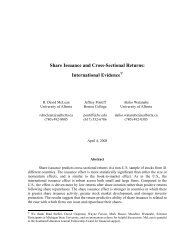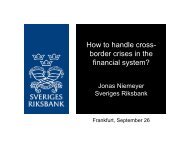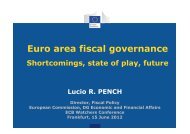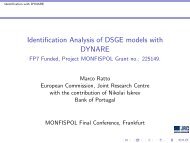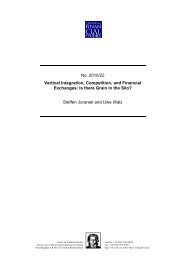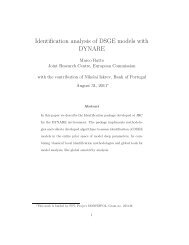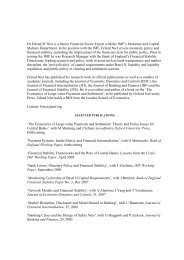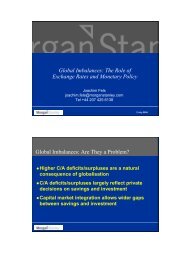Forecasting and Policy Making (Paper) - Center for Financial Studies
Forecasting and Policy Making (Paper) - Center for Financial Studies
Forecasting and Policy Making (Paper) - Center for Financial Studies
Create successful ePaper yourself
Turn your PDF publications into a flip-book with our unique Google optimized e-Paper software.
cent in 2010. As usual, the CBO’s near-term outlook was based on the assumption that ”current laws<br />
<strong>and</strong> policies governing federal spending <strong>and</strong> taxes do not change ,” <strong>and</strong> there<strong>for</strong>e did ”not include the<br />
effects of a possible fiscal stimulus package”. 1 On January 9, President Obama’s advisers Christina<br />
Romer <strong>and</strong> Jared Bernstein circulated a report on the impact of the American Recovery <strong>and</strong> Rein-<br />
vestment Plan predicting that such a plan could raise GDP by 3.6 percent above the baseline <strong>for</strong>ecast<br />
within 2 years (Romer <strong>and</strong> Bernstein, ????). Their calculations were based on measures of govern-<br />
ment spending <strong>and</strong> tax multipliers obtained from private sector <strong>for</strong>ecasters <strong>and</strong> the Federal Reserve.<br />
Over the course of January <strong>and</strong> early February 2009, CBO prepared several budgetary <strong>and</strong> economic<br />
impact <strong>for</strong>ecasts of the stimulus legislation debated <strong>and</strong> eventually passed in the House of Represen-<br />
tatives <strong>and</strong> the Senate in response to requests by members of U.S. Congress. On March 20, 2009 CBO<br />
released an update of its budget <strong>and</strong> economic outlook taking into account the policy changes implied<br />
by the ARRA as well as new incoming economic data suggesting a more negative economic outlook<br />
than the data available <strong>for</strong> the January <strong>for</strong>ecast. 2 On this basis, they predicted a steeper decline of real<br />
GDP in 2009 of -3.0 percent followed by an increase of 2.9 percent in 2010.<br />
This example shows that economic policy is not only based on macroeconomic <strong>for</strong>ecasts, but that<br />
the path of policy itself has a direct effect on projections of macroeconomic aggregates. Thus, <strong>for</strong>e-<br />
casters need to base their predictions on specific assumptions regarding future policy. For example,<br />
professional <strong>for</strong>ecasters <strong>and</strong> macroeconomists often use a particular future path <strong>for</strong> fiscal policy that<br />
they consider most likely to occur or an estimated feedback rule that accounts <strong>for</strong> the response of<br />
future policy to projected future economic conditions. Forecasters employed by policy institutions<br />
typically also consider <strong>for</strong>ecasts that are conditioned on unchanged policy as in the case of the CBO<br />
outlook. While such <strong>for</strong>ecasts do not represent their best possible prediction of the future course of<br />
events, they are often used as a benchmark <strong>for</strong> the policy debate that helps set up desirable policy<br />
changes. Another important issue concerns the choice of economic model on which the <strong>for</strong>ecast is to<br />
be conditioned. With regard to the ARRA, <strong>for</strong> example, a study by Cogan et al. (2010) using state-<br />
of-the-art New Keynesian models estimated much smaller multipliers than the models in Romer <strong>and</strong><br />
Bernstein <strong>and</strong> predicted only about 1/6 of the GDP impact. 3<br />
In the following, we will explore the use of different <strong>for</strong>ecasting techniques, macroeconomic mod-<br />
els <strong>and</strong> conditioning assumptions in economic policy making. In terms of applications, our focus will<br />
be more on monetary than on fiscal policy. Forecasts play an important role in regular monetary policy<br />
decisions such as interest rate changes, but also in the timing of unconventional policy such as quanti-<br />
tative easing, <strong>and</strong> major structural changes such as the <strong>for</strong>mation of a currency union. Many monetary<br />
economists even argue that monetary policy should use an inflation <strong>for</strong>ecast as an intermediate policy<br />
target,(Svensson, 1997). In the last twenty years a number of countries have adopted explicit inflation<br />
targeting regimes, in which the stance of policy is adjusted to ensure that the inflation rate is projected<br />
1 See Congressional Budget Office, The Budget <strong>and</strong> Economic Outlook: Fiscal Years 2009 to 2019, January 2009.<br />
2 See Congressional Budget Office, A Preliminary Analysis of the President’s Budget <strong>and</strong> an Update of CBO’s Budget<br />
<strong>and</strong> Economic Outlook, March 20, 2009.<br />
3 A first working paper version was circulated shortly after the bill was passed in February.<br />
4



